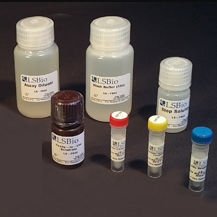
- Laboratory
- Laboratory medicine
- Research test kit
- LifeSpan BioSciences
Alkaline phosphatase assay kit LS-K301for researchserumplasma
Add to favorites
Compare this product
Characteristics
- Applications
- for research
- Tested parameter
- alkaline phosphatase
- Sample type
- serum, plasma
- Analysis mode
- fluorescence
- Result display time
20 min
- Sample volume
0.01 ml
(0.00034 US fl oz)
Description
Alkaline phosphatase (ALP) catalyzes the hydrolysis of phosphate esters in an alkaline environment, resulting in the formation of an organic radical and inorganic phosphate. In mammals, this enzyme is found mainly in the liver and bones. Marked increase in serum ALP levels, a disease known as hyperalkalinephosphatasemia, has been associated with malignant biliary obstruction, primary biliary cirrhosis, primary sclerosing cholangitis, hepatic lymphoma and sarcoidosis. Simple, direct and automation-ready procedures for measuring ALP activity in serum are becoming popular in Research and Drug Discovery. This improved Method utilizes 4-methylumbelliferyl phosphate that is hydrolyzed by ALP into a highly fluorescent product 4-methylumbelliferone. The rate of the fluorescence increase is directly proportional to the enzyme activity.
Specifications
Type
Detection/Quantition
Usage
For quantitative determination of alkaline phosphatase (ALP) activity using stable 4-methylumbelliferyl phosphate substrate.
Target
Alkaline Phosphatase
Detection
Fluorometric (Ex/Em 360/450 nm)
Supplied Components
The following components are supplied with this product.
Reagent (pH 10.5)
Standard
(See Datasheet for specific volumes supplied)
Applications
Spectrophotometry (fluorometric)
Equipment
Microplate fluorometer
Conditions
Shipped Ambient, Store at -20°C, 24 months shelf life.
Catalogs
No catalogs are available for this product.
See all of LifeSpan BioSciences‘s catalogsRelated Searches
- Assay kit
- Solution reagent kit
- Blood assay kit
- Serum assay kit
- Immunoassay assay kit
- Plasma assay kit
- Research reagent kit
- Protein reagent kit
- Laboratory reagent kit
- Optical assay kit
- Immunology reagent
- Buffer solution reagent kit
- Fluorescence assay kit
- ELISA assay kit
- Antigen assay kit
- Research assay kit
- Laboratory detection kit
- Cell assay kit
- Urine assay kit
- Tissue detection kit
*Prices are pre-tax. They exclude delivery charges and customs duties and do not include additional charges for installation or activation options. Prices are indicative only and may vary by country, with changes to the cost of raw materials and exchange rates.








































